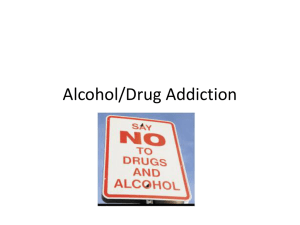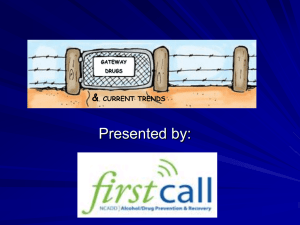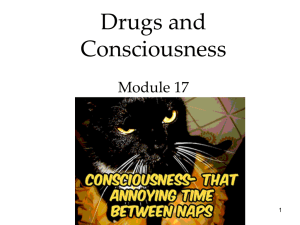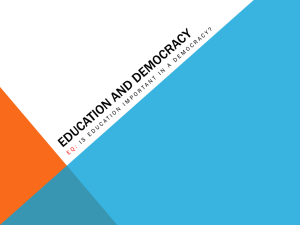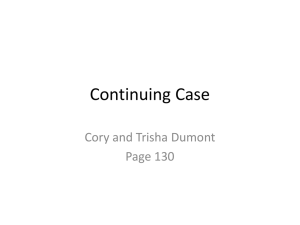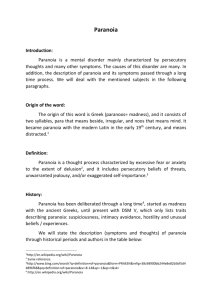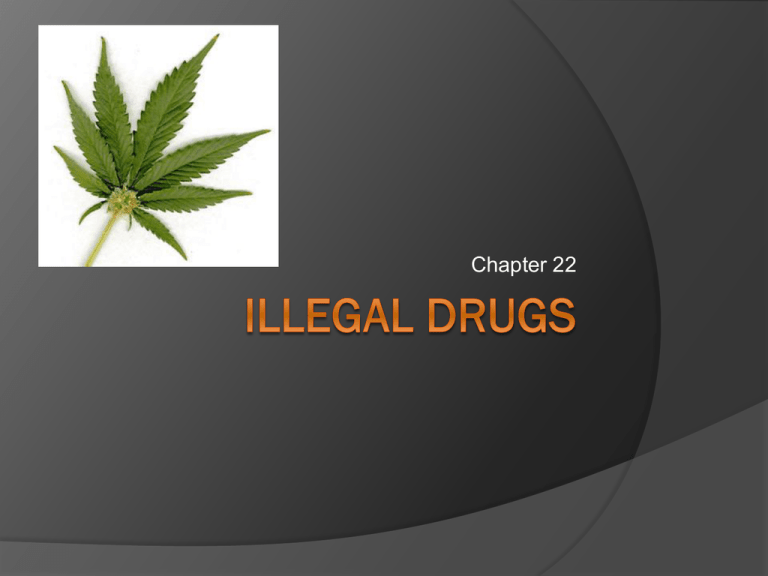
Chapter 22
Lesson 1
Do Now
Reasons to use drugs worksheet
Substance Abuse
Any unnecessary
or improper use of
chemical
substances for
non-medical
purposes
Illegal Drugs
Chemical substances that people of any
age may not lawfully manufacture,
possess, buy or sell.
Illicit Drug Use
Use or sale of any substance that is
illegal or otherwise not permitted
Including the sale of prescription drugs to
those for whom the drugs are not intended
Factors that influence teens:
Peer pressure
Family members
Role models
Media messages
Perceptions of drug behavior
Misleading information
How drugs affect your health
Physical health – risk of overdose or a
strong sometimes fatal reaction to taking
a large amount of a drug
Mental health – impair teen’s ability to
reason, think and behave
Social health – may use lose
friendships, relationships with family and
friends
Effects of Drug Use
Tolerance – body become accustomed to a
drug and the user needs more to achieve
the desired effect
Psychological dependence – person
believes that a drug is needed in order to
feel good or function normally
Physiological dependence – chemical need
for the drug may experience withdrawal
when the effects of the drug wears off
Withdrawal
Nervousness
Insomnia
Headaches
Vomiting
Chills
Cramps
In severe cases.. death
Addiction
Physiological or psychological
dependence on a drug
User requires persistent, compulsive
use of a harmful substance
Professional help is often necessary
In class assignment
Health Risks of drug use worksheet
Homework
Health risks of drug use note taking
worksheet
Lesson 2
Do Now
Drug use and athletic performance
worksheet
Consequences to the Individual
Stop pursuing interests and goals set by
themselves, parents and teachers
Engagement in harmful behaviors
Teen depression
Suicide
Legal issues
Increased violence
Accidental death
Consequences for Family and Friends
Users may stop spending time with
friends and family who value a drug-free
lifestyle
Family and friends feel responsible and
feel the burden of emotional and
financial costs of drug abuse
Consequences for others
Pregnant women can transfer
nutrients to the fetus through
the placenta
Drugs have a must greater
effect on a fetus than the
mother
Fetus may be born with
defects, behavioral problems,
or addition
Breast milk can contain traces
of drugs passed to the baby
Consequences for Society
DWI/DUI
Law enforcement
costs
Insurance costs
Health care costs and
legal fees
Lost work hours due to
drug related illnesses,
jail time, accidents and
deaths
In class assignment
DUI Dead in 5 Seconds
Homework
Oh Baby! worksheet
Lesson 3
Do Now
Marijuana pre-test
Marijuana
Plant whose leaves, buds and
flowers are usually smoked for
intoxicating effects
Most widely used illegal drug
Gateway drug – may lead the use
to try other, more dangerous drugs
Teens who use marijuana are 15x
more likely to use cocaine than
those who do not use
Health Risks
Hallucinations
Paranoia
Impaired short term
memory, reaction time,
concentration and
coordination
Decreased ambition
Bloodshot eyes
Dry mouth
Lung irritation
Heart and lung damage
Increase risk of lung
cancer
Weakened immune
system
Increased appetite
Increased risk of stillbirth
and birth defects
Changed hormone levels
Risk of infertility in
females
Low sperm count and
testosterone in males
Driving and Marijuana
10-22% of drivers in accidents were on
drugs
Marijuana interferes with depth
perception, increases reaction time,
causes sleepiness, impairs judgment
and slows reflexes
DUI
Legal consequences
of DUI include:
License suspension
Fines
Loss of eligibility for
college loans
Jail term
Inhalants
Substances who fumes are sniffed or
inhaled to achieve a high
Inhalants include:
Solvents
Aerosoles
Glues
Paints
Varnishes
Gasoline
Inhalers for asthma and allergies
Health Risks of Inhalants
Depress the CNS
Immediate effects:
Glassy stare
Slurred speech
Impaired
judgment
Nausea
Coughing
Nosebleeds
Fatigue
Lack of
coordination
Long term effects:
Liver and kidney
damage
Blindness
Brain damage
Paralysis
Cardiac arrest
death
Anabolic-androgenic steroids
Synthetic substances similar to male sex
hormones
May be prescribed for medical
conditions but use without medical
supervision is dangerous
Consequences of Steroid Use
Unnatural muscle
growth
Tendon and
ligamentous injury
Weight gain
Acne
High blood
pressure
Liver and kidney
tumors
HIV and Hepatitis
B contraction from
needle use
Violent behavior
Mood swings
Depression
Paranoia
Effects on males and females
Males
Shrinking
testicles
Reduced sperm
count
Baldness
Development of
breasts
Increased risk of
prostate cancer
Females
Facial hair
Baldness
Menstrual cycle
changes
Deepened voice
In class assignment
Declining Substance Abuse Trends
Among Teens worksheet
Marijuana and Inhalants worksheets
Homework
Marijuana, Inhalants and Steroids note
taking worksheets
Lesson 4
Do Now
How Drugs Enter the Bloodstream
worksheet
Psychoactive Drugs
Chemicals that affect the CNS and alter
activity in the brain, change the functioning
of the CNS
4 main groups:
○ Stimulants
○ Depressants
○ Opiates
○ Hallucinogens
Club Drugs
Drugs found at concerts,
dance clubs, drug parties
and races
Many club drugs are
“designer drugs” which are
synthetic and made to
imitate the effects of other
drugs and are sometimes
hundreds of times stronger
than the drugs they imitate
Ecstasy
Rohypnol
GHB
Ketamine
Meth
LSD
Stimulants
Drugs that speed
up the central
nervous system
Ecstasy (MDMA)
Stimulant and hallucinogen
May cause short-term euphoria or
feelings of intense well-being or elation
Consequences to health include:
○ Confusion
○ Depression
○ Paranoia
○ Muscle breakdown
Methamphetamine
White, odorless
powder that easily
dissolves in
alcohol or water
Readily available
from makeshift
labs
Short term feelings
of euphoria
Consequences to
health include:
○ Depression
○ Paranoia
○ Memory less
○ Delusions
○ Heart and
nerve damage
○ Addiction
Cocaine
White powder
extracted from the
leaves of the coca
plant
Users experience
a surge of selfconfidence and
euphoria followed
by emotional
letdown
Consequences to health
include:
○ Depression
○ Fatigue
○ Paranoia
○ Physiological
dependence
○ Malnutrition
○ Cardiac problems
○ Nausea
○ Abdominal pain
○ Headache
○ Stroke
○ Seizure
○ Death
○ Exposure to HIV
○ Addiction
Crack
More dangerous
form of cocaine
Reaches the brain
seconds after being
smoked or injected
Consequences to
health include:
○ Extreme increase in
heart rate and BP
○ Death may result
from cardiac or
respiratory failure
○ Mixing crack with
alcohol can be fatal
○ Extreme addiction
In class assignment
Brainstorm street names or slang terms
for drugs
Use the street names sheet and terms
from the board to categorize each under
depressants, stimulants, hallucinogens,
inhalants, narcotics/opiates and
marijuana
Homework
Stimulants and Cocaine worksheets
Lesson 5
Do Now
Understanding Ectasy
Depressants
Drugs that tend to
slow the central
nervous system
Rohypnol
“Roofies” “Daterape” drug
Colorless, odorless
and tasteless
Engaging in sexual
activity under the
influence is a
criminal offense
Consequences to
health include:
○ Decreased BP
○ Drowsiness
○ Memory loss
○ GI disturbances
○ Can result in
unwanted
physical contact,
unplanned
pregnancies and
exposure to HIV
and STD
GHB
Gamma
hydroxybutyric
Clear liquid or
white powder in
tablets and
capsules
“Date-rate” drug
Consequences to
health include:
○ Drowsiness
○ Nausea
○ Vomiting
○ Loss of
consciousness
○ Impaired
breathing
○ Coma
○ Death
Barbiturates
Sedatives that are
rarely used for
medical purposes
Combining with
alcohol can be
fatal
Consequences to
health include:
○ Mood changes
○ Excessive
sleepiness
○ Coma
○ Feeling of
intoxication
○ Fatigue
○ Confusion
○ Impaired muscle
coordination
○ Reduced heart
rate, BP,
respiratory
function
○ Death
Tranquilizers
Depressants that
relieve anxiety,
muscle spasms,
sleeplessness and
nervousness
If overused can
cause
physiological and
psychological
dependence, coma
and death
Consequences to
health include:
○ Depression
○ Fever
○ Irritability
○ Loss of
judgment
○ Dizziness
In class assignment
Drug Vocabulary worksheet
Homework
Depressants worksheet
Lesson 6
Do Now
A Tale of Woe worksheet
Opiates
Drugs such as those derived from the
opium plant that are obtainable only by
prescription and used to relieve pain
Codeine
Highly addictive
ingredient in
prescription cough
medicines
Some people may
be allergic
Linked to death in
infants
Drowsiness can
occur even when
taken as
prescribed
Consequences to
health include:
○ Dizziness
○ Labored
breathing
○ Low BP
○ Seizures
○ Respiratory
arrest
○ Exposure to
HIV
○ Addiction
○ Death
Morphine
Prescribed to treat
severe pain for a
short time
Consequences to
health include:
○ Fast or slow
heartbeat
○ Seizures
○ Hallucinations
○ Blurred vision
○ Rashes
○ Difficulty
swallowing
○ Rapid onset of
tolerance
○ addiction
Heroin
Processed form of
morphine that is
injected, snorted or
smoked.
White or brownish
powder OR black,
sticky tar
Dealers may mix
heroin with
medicines of
household
substances to
create “cheese
heroin”
Consequences to
health include:
○ Slows breathing
and HR
○ Confusion
○ Sedation
○ Unconsiousness
○ Can cause
infection in heart
lining and valves
○ Liver disease
○ Exposure to HIV
and Hepatitis B
○ Addiction
○ Coma
○ Death
○ Fetal death if
pregnant
Oxycodone
Prescription drug
to relieve moderate
to severe chronic
pain
Contains a strong
opiate
Brand name
OxyContin
Consequences to
health include:
○ Drowsiness
○ Nausea
○ Constipation
○ Addiction
○ Reduced
respiratory
function
○ Respiratory
arrest
○ Death
Hallucinogens
Drugs that alter moods, thoughts, and
sense perceptions, including vision,
hearing, smell and touch
Ketamine
Anesthetic used to
treat animals and
causes
hallucinations and
respiratory failure
Consequences to
health include:
○ Kidney and
○
○
○
○
cardiovascular
system failure
Death
Memory loss
Numbness
Impaired motor
function
LSD (Acid)
Lysergic acid
diethylamide can
cause
hallucinations,
distortions of sound
and color, and
flashbacks
Consequences to
health include:
○ Extreme euphoria
○ Extreme panic or
○
○
○
○
○
○
○
terror
Deep depression
Delusions
Illusions
Hallucinations
Flashbacks
Numbness
Tremors
PCP
Angel dust
Most dangerous of
all drugs
Effects vary greatly
for each user
Distortions and lack
of sensitivity cause
many deaths
Consequences to
health include:
○ Increased muscle
○
○
○
○
○
○
strength
Increased feelings of
violence
Inability to feel pain
Loss of appetite
Depression
Panic
Aggression
DXM
“Tussin” cough
suppressant sold OTC
When used correctly
is not dangerous
Consequences to
health include:
○ Nausea
○ Dizziness
○ Lack of coordination
○ Rashes
○ Hallucinations
○ Disorientation
○ Paranoia
○ Panic attacks
○ Seizures
○ Increased heart rate
and BP
○ Addiction
Mushrooms and Peyote
Hallucinogens found
in nature as a
fungus and plant
When eaten cause
hallucinations
nausea and
flashbacks
Consequences to
health include:
○ Delusions
○ Illusions
○ Hallucinations
○ Paranoia
○ Extreme anxiety
○ Nausea
○ Poisoning and death
Homework
Narcotics and Hallucinogens worksheet
Lesson 7
Do Now
Understanding Drug Types
Resisting Pressure
Refusal strategies
“No thanks, I don’t do drugs.”
“I can’t. I’m on medication.”
“I’m not interested. That stuff makes me
sick.”
“No. I have to be in great shape for
tomorrow’s game.”
Healthy Alternatives
Hobbies
Sports
Community
School organization
Drug Prevention
School Efforts
○ Drug-free school zones – areas within 1,000 to 1,500
feet of school and designated by signs, within which
people caught selling drugs receive especially severe
penalties (double what they might be elsewhere)
○ Locker searches
○ Drug education classes
○ Zero-tolerance policies
Community Efforts
○ Drug watches – organized community efforts by
neighborhood residents to patrol, monitor, report and
otherwise try to stop drug deals and drug abuse
Warning Signs of Drug Use
Lies about drugs he or she is using
Stops participating in normal activities
Changes eating or sleeping habits
Takes unnecessary risks
Gets in trouble
Seems withdrawn, depressed, tired
Red-rimmed eyes, runny nose not related to
allergies
Blackouts
Difficulty concentrating
Becoming Drug Free
Identify sources of help in your
community
Talk to the person when he or she is
sober, express affection and concern
without judgment
Listen to the person’s response. Be
prepared for anger and denial
Offer to go with your friend or family
member to counseling or a support
group
Getting Help
Rehabilitation – process of medical and
psychological treatment for physiological
or psychological dependence on a drug
or alcohol
Outpatient drug-free treatment
Short term treatment
Maintenance therapy
Therapeutic communities
In class assignment
Living Drug Free/ Test Prep worksheet
Homework
Living Drug Free notetaking
Review
Lesson 8
Extra Credit
Directory of resources (10pts)
In class assignment
Save the best for last worksheet

